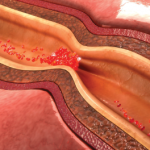The investigators found all tissue samples had C3 and that parent complement deposition occurred within the vascular wall in all patients with coronary artery disease, regardless of inflammatory rheumatic disease status. The deposition of C3 formed a diffuse pattern in the aortic media and adventitia of all samples tested. They also found the C3 activation product C3d deposited in a diffuse pattern throughout the aortic media of all tissue specimens regardless of inflammatory rheumatic disease status. However, C3d was found only in the adventitia of patients with inflammatory rheumatic disease.
When the researchers focused their attention on patients undergoing coronary artery bypass grafting, they found those with inflammatory rheumatic disease had higher plasma terminal complement complexes and more complement activation in the vascular adventitia than non-inflammatory rheumatic disease patients. This difference was pronounced, even though the two groups (with and without inflammatory rheumatic disease) had similar levels of circulating p-C3. The authors concluded their paper by suggesting that the exaggerated systemic and vascular complement activation in patients with inflammatory rheumatic disease may accelerate cardiovascular disease, serve as a cardiovascular disease biomarker and act as a target for new therapies.
Lara C. Pullen, PhD, is a medical writer based in the Chicago area.
Reference
- Shields KJ, Mollnes TE, Eidet JR, et al. Plasma complement and vascular complement deposition in patients with coronary artery disease with and without inflammatory rheumatic diseases. PLoS One. 2017 Mar 31;12(3):e0174577. doi: 10.1371/journal.pone.0174577. eCollection 2017.
